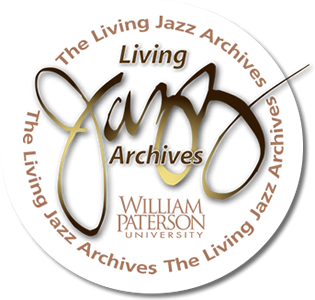
This effort began in 2001 when the leadership of the Vanguard Jazz Orchestra approached Professor David Demsey with the proposal to make William Paterson University the repository for original scores and parts by the iconic composer/arranger/trumpeter Thad Jones, a fitting location since Jones was William Paterson’s first jazz studies director. The parts were deteriorating from use and were in the process of being replaced by digital copies. The University responded by creating the Thad Jones Archive, with an opening concert and ceremony on April 25, 2002 featuring the Vanguard Jazz Orchestra with the William Paterson University Jazz Orchestra. The materials were stored at that time in the university’s Cheng Library.
The next, historic step in the creation of the Living Jazz Archives came with Clark and Gwen Terry’s announcement in spring 2004 that they had chosen William Paterson University to be the site of his permanent archive. On December 8, 2004 the Clark Terry Archive was officially begun with a ceremony and concert, containing a huge amount of materials from the historic trumpeter and educator, one of the founders of the jazz education movement. Cataloging and organization of those materials began the next year at the Terrys’ Haworth, NJ home by David Demsey with assistance from then graduate student Cameron MacManus. The Terrys’ relocation to Pine Bluff, Arkansas in the summer of 2006 brought the donation of a major amount of material, transferred to the campus in the summer of 2007. Simultaneously, President Arnold Speert and Provost Edward Weil donated space for the Living Jazz Archives on the third floor of College Hall.
The untimely July 2004 death of Prof. James Williams, Director of Jazz Studies since September 1999 and a major jazz pianist and composer, led to the next donation. Williams’ family, led by his brothers Hannibal and Ralph Parks with James’ nephew Tony Reedus, expressed their wish that William Paterson University care for his materials. The James Williams Archive was created in the fall of 2004; cataloguing work began in Professor Williams’ office and subsequently moved to the new Archive.

The Living Jazz Archives space officially opened on April 24, 2008, with a concert by Clark Terry and the William Paterson University Jazz Orchestra, featuring a program of historic jazz arrangements from the Clark Terry Archive.
Jazz alumnus James Terrile made a generous donation in the fall of 2007 that enabled the University to purchase audio and video equipment, exhibit cases and shelving to make the Archives space a reality. Since then, other donors and William Paterson alumni have continued to annually fund the ongoing growth and vitality of the archive collections. The Living Jazz Archives Endowment was created, accepting donations beginning in 2020, creating a permanent annual operating Archives budget.
Momentum has continued to build since the creation of these initial archives. Additional artists and artists’ families have come to the Living Jazz Archives with their materials because of the work that has been accomplished with the original archives. William Paterson University now houses the archive of the iconic, influential saxophonist Michael Brecker since 2013, and of the uniquely melodic trumpeter Art Farmer, begun in 2019. Two important and influential arrangers, Don Sebesky and Jim McNeely, have each donated hundreds of scores and other important materials to create their collections in 2017 and 2018 respectively. Veteran New York saxophonist and woodwind performer Albert Regni donated his large library of American Saxophone Quartet repertoire and other saxophone solo and quartet music in 2018; that collection has been augmented by the Ray Beckenstein New York Saxophone Quartet collection of recordings and other materials. The early history of the William Paterson Jazz Program is contained in the photographic collection of Martin and Joann Krivin.
At this writing, the addition of more collections is planned. The Living Jazz Archives continue to bring together the worlds of archival work and education, fulfilling Clark Terry’s dream by storing these vital materials at the highest possible archival level, while putting copies on students’ music stands and in their ongoing classes and lessons.

